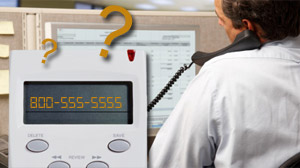If the Caller ID reads “MICROSOFT SUPPORT - 1-800-555-1212” or something similar, then most people would tend to believe that the person on the other end of the line is really from Microsoft. A lot of people don’t realize that scammers are using Voice Over IP technology and other tricks to fake or "spoof" Caller ID information.Scammers use Caller ID spoofing to help make their scams seem more believable.
How do scammers spoof their Caller ID information?
There are several ways in which scammers spoof Caller ID information. One of the most popular ways that scammers spoof their Caller ID is through the use of special internet-based caller ID spoofing service providers. These spoofing services can be purchased cheaply and are often sold as a re-loadable calling card.
The typical Caller ID spoof works like this:
The person (scammer) wanting to conceal their number logs into a 3rd party spoofing service provider website and submits their payment information.
Once logged in to the site, the scammer provides their real phone number. They then enter the phone number of the person (victim) they are calling and provide the fake information that they want the caller ID to show as.
The spoofing service then calls the scammer back at the phone number they provided, calls the intended victim's number, and bridges the calls together along with the spoofed Caller ID information. The victim sees the fake Caller ID information as they pick up the phone and are connected to the scammer.
Caller ID spoofing can be an incredibly effective tool for scammers. The recent Ammyy scam, where victims receive phone calls from scammers claiming to be from Microsoft support, is a huge scam that has bilked people out of millions of dollars worldwide.
The Ammyy scam wouldn’t be nearly as effective if it wasn't for Caller ID spoofing. When Ammyy scam victims answer the phone, most of them have already looked at the Caller ID on their phone to see that it says that "Microsoft" is calling them, and many of them believe it.
The scamming technique used in the Ammyy scam is known as pretexting. Pretexting is when someone creates an artificial scenario so that they can mask their true intentions under the guise of something that is non-threatening. The pretext usually involves developing credibility so that it is more acceptable and believable.
An example of establishing false credibility for pretexting would be someone using a police uniform in order to pass themselves off as a police officer to get access to a section of a building that is normally off-limits.
Caller ID in scams is used in the same manner as a phony police uniform would be in the real world. When most people are trying to determine a caller’s identity all they have to go by is who the person says they are and who the Caller ID says they are. If this information matches, then most reasonable people believe the pretext and will often end up a victim of the scam.
Is Spoofing Caller ID information illegal?
In the US and many other countries, it is illegal to falsify Caller ID information. The United States Truth in Caller ID Act was recently signed into law and makes it illegal to spoof caller ID information for unlawful purposes.
If you live in the US and believe that someone calling you has spoofed their caller ID information in order to scam or mislead you, then you can report it to the Federal Communications Commission (FCC).
What Can You do to Protect Yourself Against Caller ID Spoofing?
Don’t place all your trust in the Caller ID information presented to you
Now that you know that this information is easily spoofed by the use of 3rd party Caller ID spoofing services and other tools, you won't be as trusting in the technology as you have been. This should help you in the quest to Scam-proof Your Brain.
Never give credit card information out to someone who has called you
It’s a personal rule of mine that I don’t conduct any business over the phone where I haven’t initiated the call. Get a call back number and call back if you are interested in a product or service. Use Google to reverse lookup their phone number and see if it is associated with a known scam.


